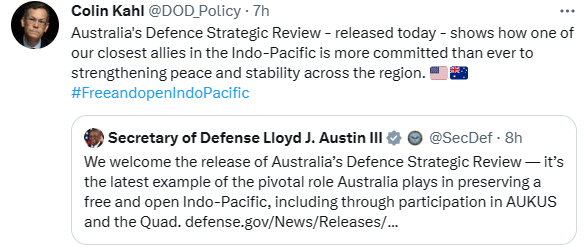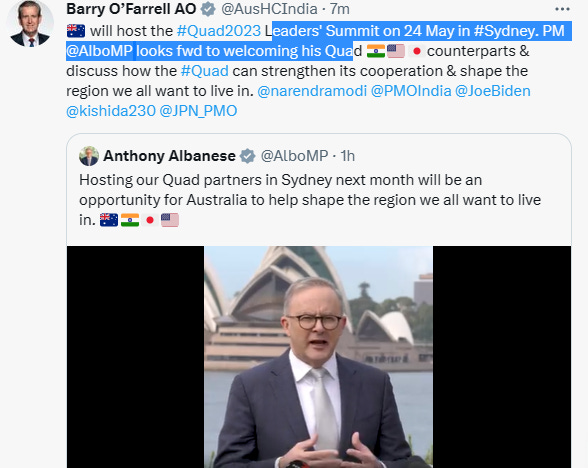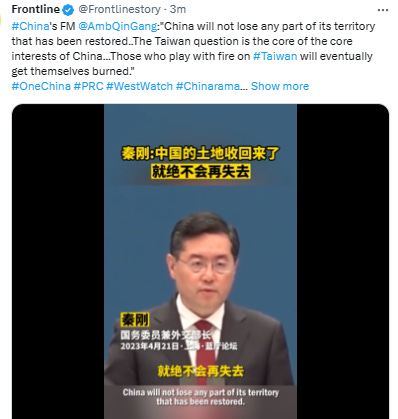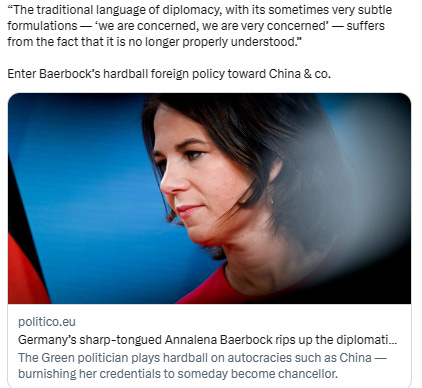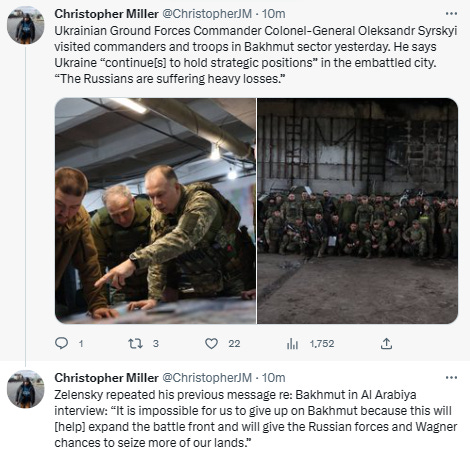Lithuania, host of NATO Summit this year, spat with China in last 24 hours. Zelensky asked again about jet fighters for counter-offensive next month, Ukraine critical “win or lose.” Australia PM Anthony Norman Albanese agree to join this Summit same as last year in Madrid. Then, minutes ago, Australia Government unveiled biggest overhaul on Australia military in the last 35 year. But the whole biggest overhaul, lookalike, just anticipating: China.
The defence strategic review is billed by the Albanese government as the most significant update of defence planning in 35 years. In addition to defending Australia and the immediate region, the ADF will be required to 'deter through denial any adversary’s attempt to project power against Australia through our northern approaches'. The more expansive tasks for the ADF are: to protect Australia’s economic connections to the world, contribute with partners to the collective security of the Indo-Pacific, and contribute with partners to maintain the global rules-based order.
2 Days ago, FM Taiwan Joseph Wu said: “We are taking the Chinese military threat (to Taiwan) very seriously … I think 2027 is the year that we need to be serious about.” This prediction 1 year longer than CSIS simulation (2026).
Only less than 10 hours after Joseph’s comment, Philippines President Ferdinand (Bong Bong) Marcos Jr. on Saturday met with Chinese Foreign Minister Qin Gang to "iron things out" amid tension with China over its growing assertiveness in the region. Distance Manila with Taipei only 730 miles.
In a statement after his meeting with Qin in Malacañang, Marcos noted that "some of the pronouncements that have been made recently by our two countries and many other countries might be misinterpreted."
"So today it was really useful that we were able to speak with Minister Qin Gang, the foreign minister of China, so we can talk directly to one another and iron things out," the President said.
"It's very, very useful and very, very productive that Minister Qin came here and that we were able to talk things a little bit through, make plans for the future, continue to work on growing the relationship between the Philippines and China, not only in the economic field but in the cultural and educational and other exchanges," he added.
As to the conflicts, Marcos said they agreed "to establish more lines of communications so that any event that occurs in the West Philippine Sea that involves China and the Philippines can immediately be resolved."
US intelligence believes that Xi Jinping, China’s leader, has ordered the country’s military to be ready by 2027 to annex Taiwan. China regards Taiwan, a democratic and self-governing island, as a renegade province that must be reunited with the mainland. Since he came to power in 2012, Xi has stressed that the Taiwan issue “cannot be passed on from generation to generation”.
On Friday, China’s foreign minister, Qin Gang, said both sides of the Taiwan strait belonged to China, and that “those who play with fire on Taiwan will eventually get themselves burned”.
Some US officials believe a conflict may come sooner. In January, Gen Mike Minihan, a former deputy commander for US Indo-Pacific command, said his “gut” told him to expect a conflict in 2025.
Back to Australia.
Australia refocusing the armed forces on deterring would-be foes far from its shores. Sketching a future in which Australia would have substantially longer-range strike capability, Defence Minister Richard Marles said the decades-old territory-focused strategy was "no longer fit for purpose".
Facing a more combative China, he said Australia will shift its focus to deterring enemies before they reach its shores - at sea, in the air and online.
"Today, for the first time, in 35 years, we are recasting the mission of the Australian Defence Force," Mr Marles said.
The long-awaited strategic review by the defence ministry said Beijing's military build-up is now the largest and most ambitious of any country since World War II.
"This build-up is occurring without transparency or reassurance to the Indo-Pacific region of China's strategic intent," the review said, using another term for the Asia-Pacific.
"China's assertion of sovereignty over the South China Sea threatens the global rules-based order in the Indo-Pacific in a way that adversely impacts Australia's national interests."
Australia has already announced a key tool in its new strategy -- the development of stealthy long-range nuclear-powered submarines.
Building on that, the Australian Defence Force will acquire long-range missile strike capabilities, both air- and land-launched.
There will be a short independent review this year of the navy's surface combatant fleet to ensure its size, structure and composition complement the capabilities provided by the new nuclear-powered submarines.
The Australian army will focus more sharply on coastal defence, particularly along the country's vast north.
As a result, a plan to purchase 450 infantry fighting vehicles will be scaled back to just 129.
Australian military planners have viewed China's military rise warily, fearing that Beijing's now-vast capabilities could effectively cut Australia off trading partners and global supply chains.
The return of major power strategic competition between China and the United States "should be seen as the defining feature of our region and time", the review said.
The public version of the classified review recommended Australia's government spend more on defense than the current expenditure of 2% of gross domestic product, improve the Australian Defense Force’s ability to precisely strike targets at longer ranges and make munitions domestically.
Other recommendations include improving the force’s ability to operate from Australia’s northern bases and to deepen defense partnerships with key partners in the Indo-Pacific region including India and Japan.
China’s military buildup “is now the largest and most ambitious of any country” since the end of World War II, the review said. And it "is occurring without transparency or reassurance to the Indo-Pacific region of China’s strategic intent,” the review added.
The strategic circumstances during the current review were “radically different" than those in the past, said the review authored by former Australian Defense Force Chief Angus Houston and former Defense Minister Stephen Smith.
The United States, Australia’s most important defense treaty partner, was “no longer the unipolar leader of the Indo-Pacific,” a region that had seen the return of major power strategic competition, it said.
“As a consequence, for the first time in 80 years, we must go back to fundamentals, to take a first-principles approach as to how we manage and seek to avoid the highest level of strategic risk we now face as a nation: the prospect of major conflict in the region that directly threatens our national interest,” the review said.
The government immediately plans to delay or abandon 7.8 billion Australian dollars ($5.2 billion) in defense spending to reflect new priorities.
Defense Industry Minister Pat Conroy said as part of the new priorities, an order for infantry fighting vehicles had been reduced from 450 to 129. The savings from those vehicles and the cancelation of a second regiment of self-propelled howitzers would fund the acceleration of Australia arming itself with the U.S. rocket system HIMARS that was proving effective in the Ukraine war.
The army’s maximum range of weapons would be extended from 40 kilometers (25 miles) to over 300 km (186 miles) and, with the acquisition of precision strike missiles, over 500 km (311 miles), Conroy said.
“This is about giving the Australian army the fire power and mobility it needs into the future to face whatever it needs to face,” Conroy said.
For the past five decades, Australia’s defense policy had been aimed at deterring and responding to potential low-level threats from a small or middle-power neighbors. “This approach is no longer fit for purpose,” the review said.
Australia’s army, air force and navy needed to focus on “delivering timely and relevant capability” and abandon its “pursuit of the perfect solution or process” in its procurements, it said.






